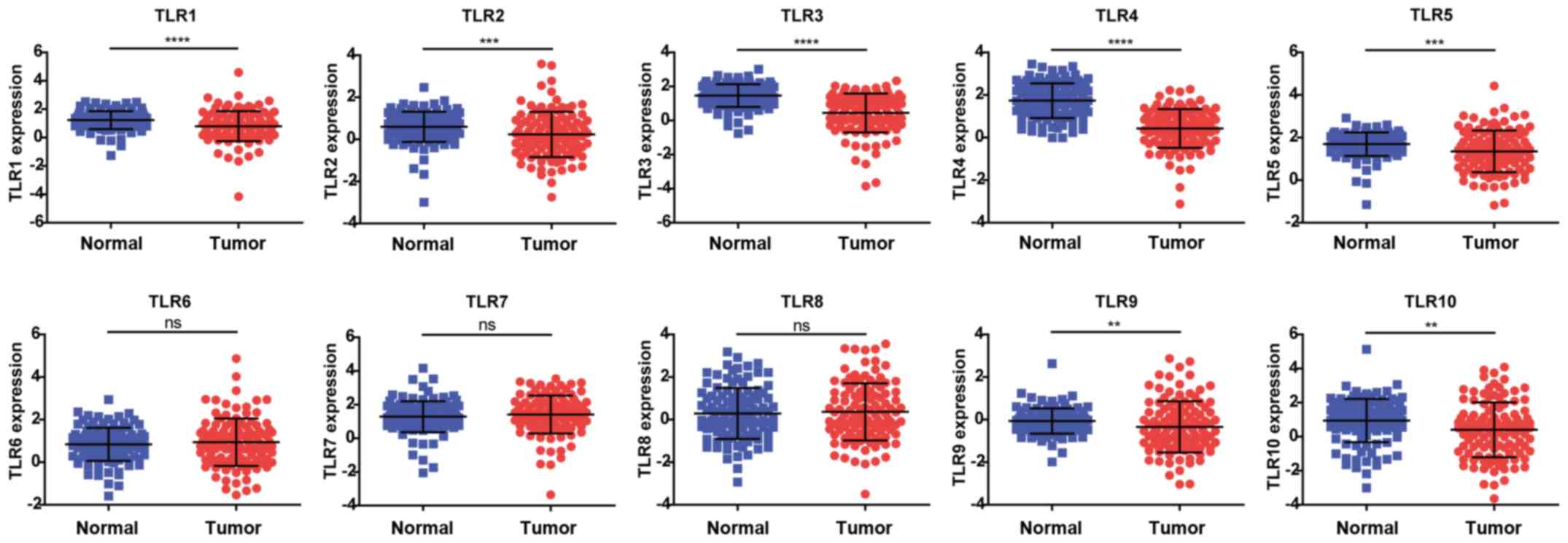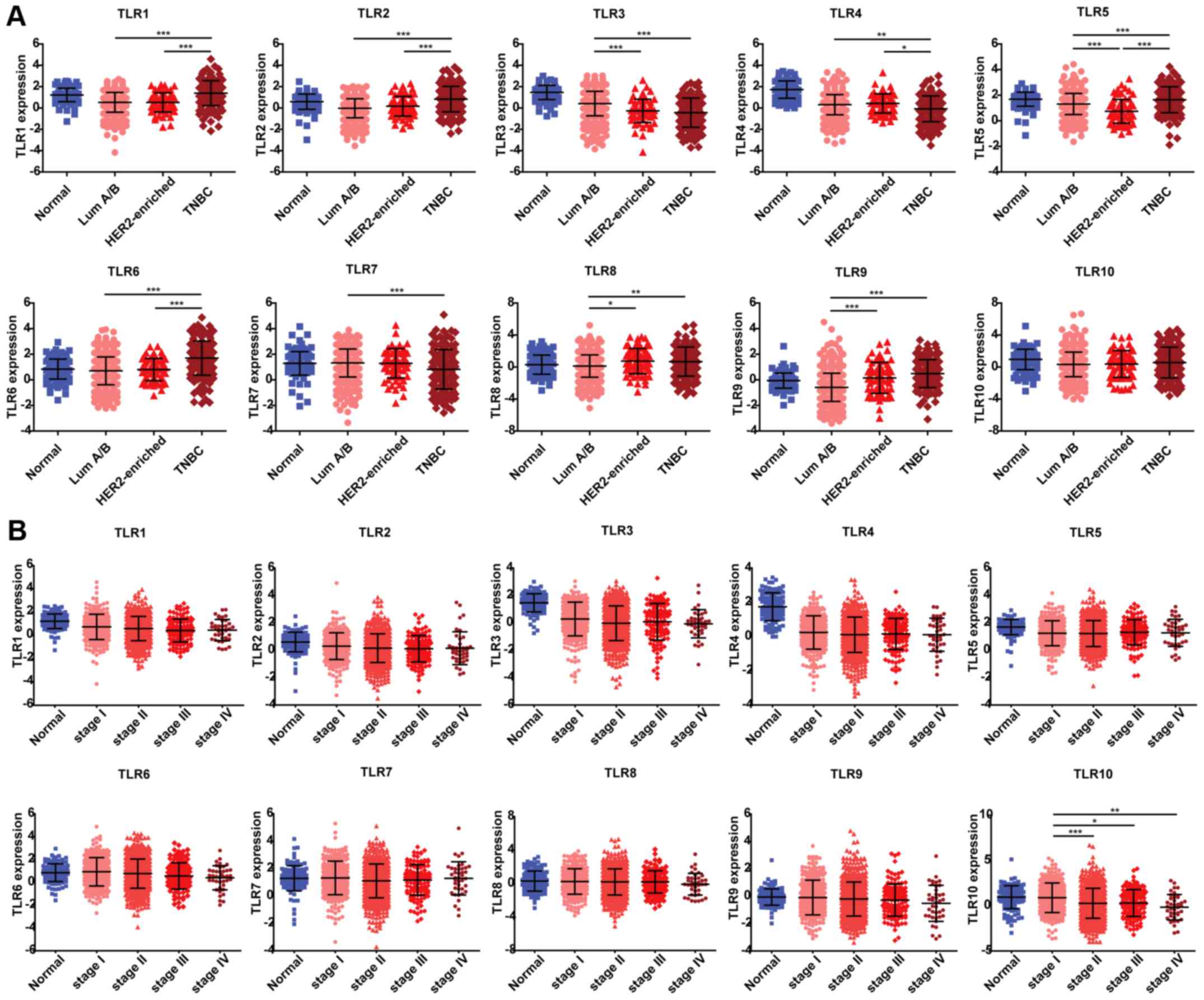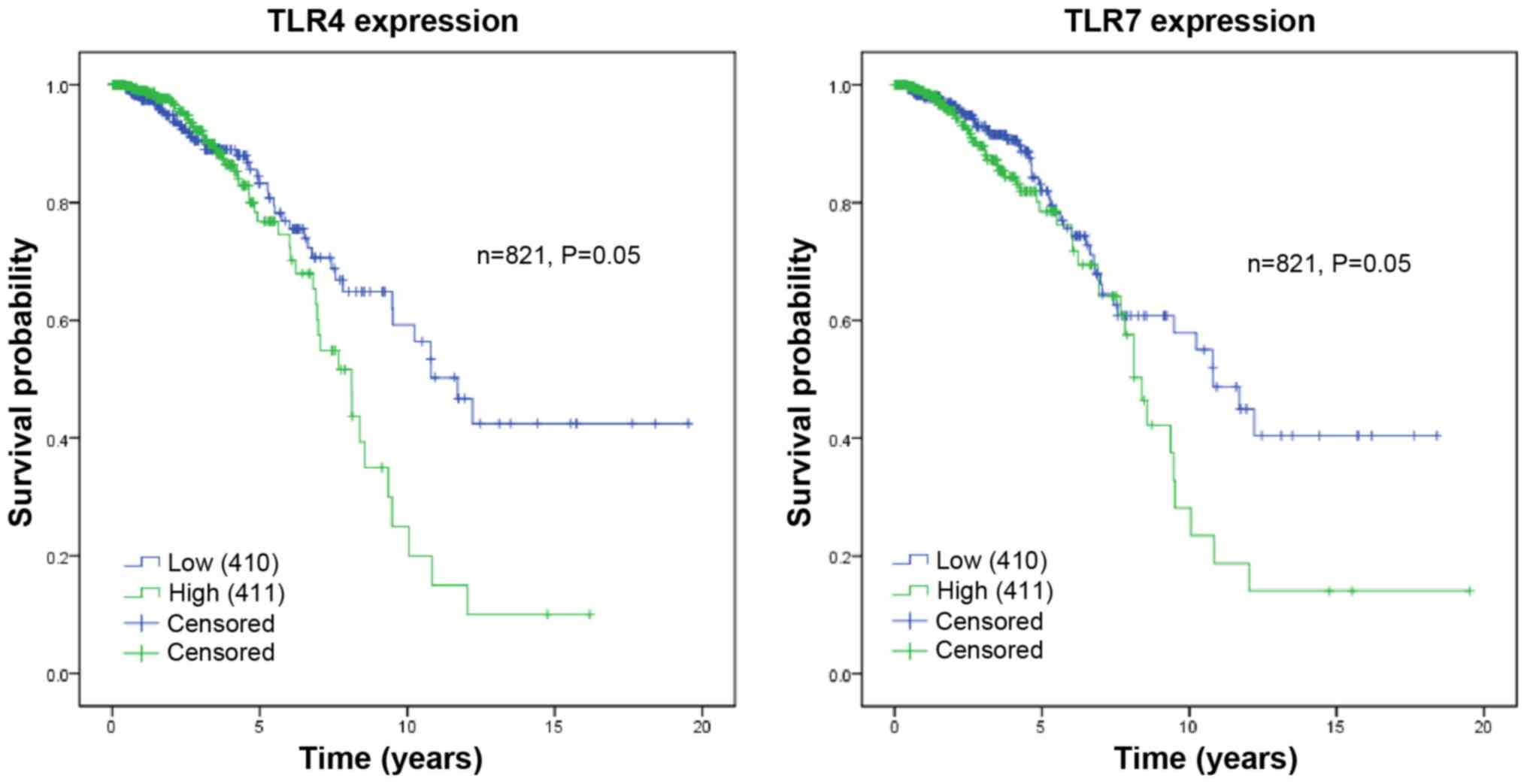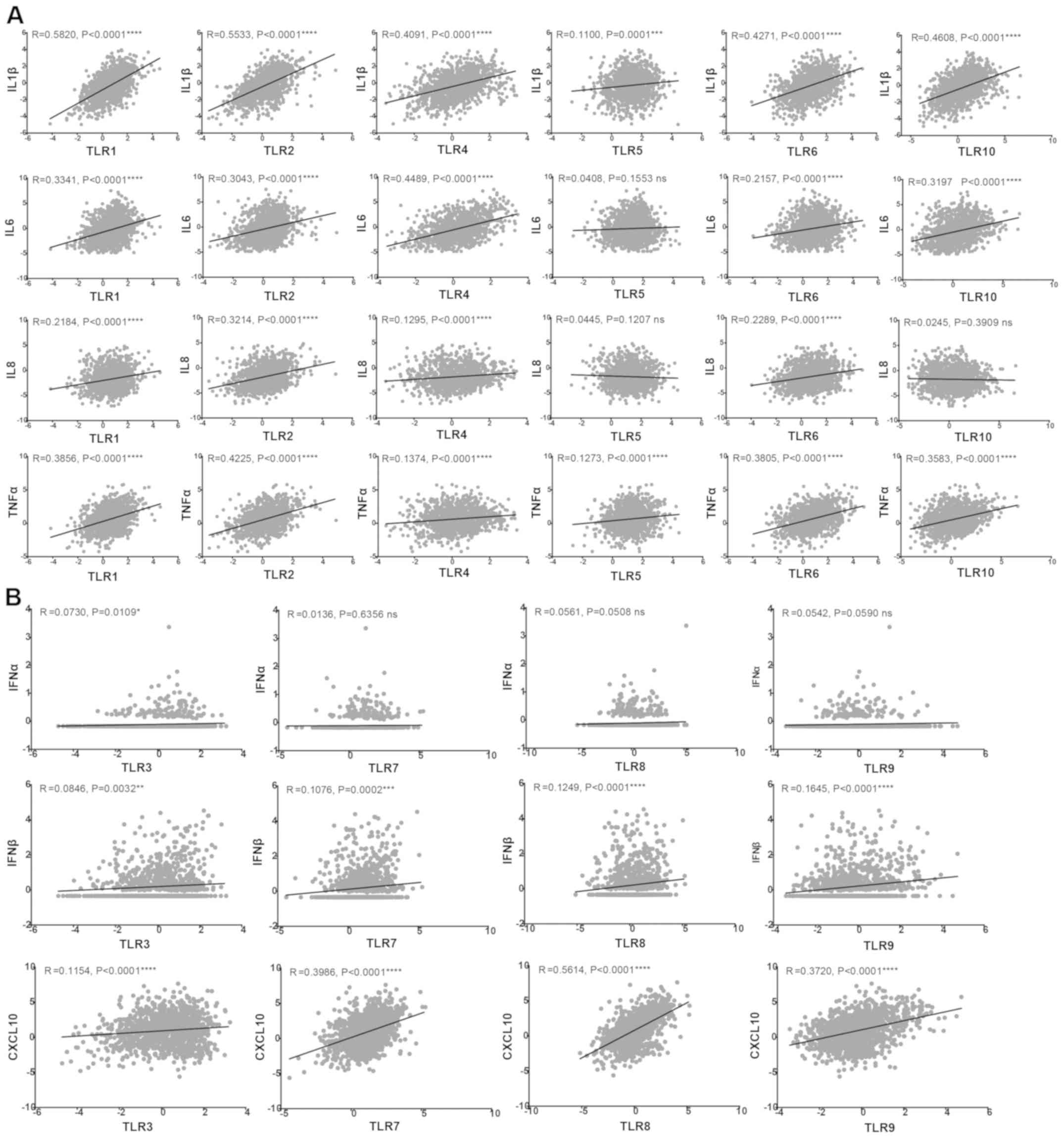|
1
|
Mifsud EJ, Tan AC and Jackson DC: TLR
Agonists as modulators of the innate immune response and their
potential as agents against infectious disease. Front Immunol.
5:792014. View Article : Google Scholar : PubMed/NCBI
|
|
2
|
Brubaker SW, Bonham KS, Zanoni I and Kagan
JC: Innate immune pattern recognition: A cell biological
perspective. Annu Rev Immunol. 33:257–290. 2015. View Article : Google Scholar : PubMed/NCBI
|
|
3
|
Palm E, Demirel I, Bengtsson T and Khalaf
H: The role of Toll-like and protease-activated receptors in the
expression of cytokines by gingival fibroblasts stimulated with the
periodontal pathogen Porphyromonas gingivalis. Cytokine.
76:424–432. 2015. View Article : Google Scholar : PubMed/NCBI
|
|
4
|
Johnston DG and Corr SC: Toll-like
receptor signalling and the control of intestinal barrier function.
Methods Mol Biol. 1390:287–300. 2016. View Article : Google Scholar : PubMed/NCBI
|
|
5
|
Rakoff-Nahoum S and Medzhitov R: Toll-like
receptors and cancer. Nat Rev Cancer. 9:57–63. 2009. View Article : Google Scholar : PubMed/NCBI
|
|
6
|
Yu L and Chen S: Toll-like receptors
expressed in tumor cells: Targets for therapy. Cancer Immunol
Immunother. 57:1271–1278. 2008. View Article : Google Scholar : PubMed/NCBI
|
|
7
|
Siegel RL, Miller KD and Jemal A: Cancer
statistics, 2018. CA Cancer J Clin. 68:7–30. 2018. View Article : Google Scholar : PubMed/NCBI
|
|
8
|
Chen W, Zheng R, Baade PD, Zhang S, Zeng
H, Bray F, Jemal A, Yu XQ and He J: Cancer statistics in China,
2015. CA Cancer J Clin. 66:115–132. 2016. View Article : Google Scholar : PubMed/NCBI
|
|
9
|
Dai X, Li T, Bai Z, Yang Y, Liu X, Zhan J
and Shi B: Breast cancer intrinsic subtype classification, clinical
use and future trends. Am J Cancer Res. 5:2929–2243.
2015.PubMed/NCBI
|
|
10
|
Sørlie T, Perou CM, Tibshirani R, Aas T,
Geisler S, Johnsen H, Hastie T, Eisen MB, van de Rijn M, Jeffrey
SS, et al: Gene expression patterns of breast carcinomas
distinguish tumor subclasses with clinical implications. Proc Natl
Acad Sci USA. 98:10869–10874. 2001. View Article : Google Scholar : PubMed/NCBI
|
|
11
|
Perou CM, Sørlie T, Eisen MB, van de Rijn
M, Jeffrey SS, Rees CA, Pollack JR, Ross DT, Johnsen H, Akslen LA,
et al: Molecular portraits of human breast tumours. Nature.
406:747–752. 2000. View
Article : Google Scholar : PubMed/NCBI
|
|
12
|
Yadav BS, Chanana P and Jhamb S:
Biomarkers in triple negative breast cancer: A review. World J Clin
Oncol. 6:252–263. 2015. View Article : Google Scholar : PubMed/NCBI
|
|
13
|
Xie W, Wang Y, Huang Y, Yang H, Wang J and
Hu Z: Toll-like receptor 2 mediates invasion via activating
NF-kappaB in MDA-MB-231 breast cancer cells. Biochem Biophys Res
Commun. 379:1027–1032. 2009. View Article : Google Scholar : PubMed/NCBI
|
|
14
|
Salaun B, Zitvogel L, Asselin-Paturel C,
Morel Y, Chemin K, Dubois C, Massacrier C, Conforti R, Chenard MP,
Sabourin JC, et al: TLR3 as a biomarker for the therapeutic
efficacy of double-stranded RNA in breast cancer. Cancer Res.
71:1607–1614. 2011. View Article : Google Scholar : PubMed/NCBI
|
|
15
|
Haricharan S and Brown P: TLR4 has a
TP53-dependent dual role in regulating breast cancer cell growth.
Proc Natl Acad Sci USA. 112:E3216–E3225. 2015. View Article : Google Scholar : PubMed/NCBI
|
|
16
|
Ehsan N, Murad S, Ashiq T, Mansoor MU, Gul
S, Khalid S and Younas M: Significant correlation of TLR4
expression with the clinicopathological features of invasive ductal
carcinoma of the breast. Tumour Biol. 34:1053–1059. 2013.
View Article : Google Scholar : PubMed/NCBI
|
|
17
|
Cai Z, Sanchez A, Shi Z, Zhang T, Liu M
and Zhang D: Activation of Toll-like receptor 5 on breast cancer
cells by flagellin suppresses cell proliferation and tumor growth.
Cancer Res. 71:2466–2475. 2011. View Article : Google Scholar : PubMed/NCBI
|
|
18
|
Shuang C, Weiguang Y, Zhenkun F, Yike H,
Jiankun Y, Jing X, Xinghan L, Yue L and Dalin L: Toll-like receptor
5 gene polymorphism is associated with breast cancer
susceptibility. Oncotarget. 8:88622–88629. 2017. View Article : Google Scholar : PubMed/NCBI
|
|
19
|
Berger R, Fiegl H, Goebel G, Obexer P,
Ausserlechner M, Doppler W, Hauser-Kronberger C, Reitsamer R, Egle
D, Reimer D, et al: Toll-like receptor 9 expression in breast and
ovarian cancer is associated with poorly differentiated tumors.
Cancer Sci. 101:1059–1066. 2010. View Article : Google Scholar : PubMed/NCBI
|
|
20
|
Merrell MA, Ilvesaro JM, Lehtonen N, Sorsa
T, Gehrs B, Rosenthal E, Chen D, Shackley B, Harris KW and Selander
KS: Toll-like receptor 9 agonists promote cellular invasion by
increasing matrix metalloproteinase activity. Mol Cancer Res.
4:437–447. 2006. View Article : Google Scholar : PubMed/NCBI
|
|
21
|
Ridnour LA, Cheng RY, Switzer CH, Heinecke
JL, Ambs S, Glynn S, Young HA, Trinchieri G and Wink DA: Molecular
pathways: Toll-like receptors in the tumor microenvironment-poor
prognosis or new therapeutic opportunity. Clin Cancer Res.
19:1340–1346. 2013. View Article : Google Scholar : PubMed/NCBI
|
|
22
|
Sato Y, Goto Y, Narita N and Hoon DS:
Cancer cells expressing Toll-like receptors and the tumor
microenvironment. Cancer Microenviron. 2 (Suppl 1):S205–S214. 2009.
View Article : Google Scholar
|
|
23
|
Wang X, Smith C and Yin H: Targeting
Toll-like receptors with small molecule agents. Chem Soc Rev.
42:4859–4866. 2013. View Article : Google Scholar : PubMed/NCBI
|
|
24
|
Kidd LC, Rogers EN, Yeyeodu ST, Jones DZ
and Kimbro KS: Contribution of Toll-like receptor signaling
pathways to breast tumorigenesis and treatment. Breast Cancer (Dove
Med Press). 5:43–51. 2013.PubMed/NCBI
|
|
25
|
Green TL, Santos MF, Ejaeidi AA, Craft BS,
Lewis RE and Cruse JM: Toll-like receptor (TLR) expression of
immune system cells from metastatic breast cancer patients with
circulating tumor cells. Exp Mol Pathol. 97:44–48. 2014. View Article : Google Scholar : PubMed/NCBI
|
|
26
|
Amarante MK, de Oliveira KB, Guembarovski
RL, da Silva do Amaral Herrera AC, Guembarovski AL, Sobrinho WJ,
Voltarelli JC and Watanabe MA: Toll-like receptor 3: implications
for proinflammatory microenvironment in human breast cancer. Mol
Biol Rep. 39:11087–11092. 2012. View Article : Google Scholar : PubMed/NCBI
|
|
27
|
González-Reyes S, Marín L, González L,
González LO, del Casar JM, Lamelas ML, González-Quintana JM and
Vizoso FJ: Study of TLR3, TLR4 and TLR9 in breast carcinomas and
their association with metastasis. BMC Cancer. 10:6652010.
View Article : Google Scholar : PubMed/NCBI
|
|
28
|
Yang H, Zhou H, Feng P, Zhou X, Wen H, Xie
X, Shen H and Zhu X: Reduced expression of Toll-like receptor 4
inhibits human breast cancer cells proliferation and inflammatory
cytokines secretion. J Exp Clin Cancer Res. 29:922010. View Article : Google Scholar : PubMed/NCBI
|
|
29
|
Yeyeodu ST, Kidd LR, Oprea-Ilies GM, Burns
BG, Vancleave TT, Shim JY and Kimbro KS: IRAK4 and TLR3 sequence
variants may alter breast cancer risk among African-American women.
Front Immunol. 4:3382013. View Article : Google Scholar : PubMed/NCBI
|
|
30
|
Jukkola-Vuorinen A, Rahko E, Vuopala KS,
Desmond R, Lehenkari PP, Harris KW and Selander KS: Toll-like
receptor-9 expression is inversely correlated with estrogen
receptor status in breast cancer. J Innate Immun. 1:59–68. 2009.
View Article : Google Scholar : PubMed/NCBI
|
|
31
|
Mehmeti M, Allaoui R, Bergenfelz C, Saal
LH, Ethier SP, Johansson ME, Jirström K and Leandersson K:
Expression of functional toll like receptor 4 in estrogen
receptor/progesterone receptor-negative breast cancer. Breast
Cancer Res. 17:1302015. View Article : Google Scholar : PubMed/NCBI
|
|
32
|
Lu H, Wagner WM, Gad E, Yang Y, Duan H,
Amon LM, Van Denend N, Larson ER, Chang A, Tufvesson H and Disis
ML: Treatment failure of a TLR-7 agonist occurs due to
self-regulation of acute inflammation and can be overcome by IL-10
blockade. J Immunol. 184:5360–5367. 2010. View Article : Google Scholar : PubMed/NCBI
|
|
33
|
Bhatelia K, Singh K and Singh R: TLRs:
Linking inflammation and breast cancer. Cell Signal. 26:2350–2357.
2014. View Article : Google Scholar : PubMed/NCBI
|
|
34
|
Motshwene PG, Moncrieffe MC, Grossmann JG,
Kao C, Ayaluru M, Sandercock AM, Robinson CV, Latz E and Gay NJ: An
oligomeric signaling platform formed by the Toll-like receptor
signal transducers MyD88 and IRAK-4. J Biol Chem. 284:25404–25411.
2009. View Article : Google Scholar : PubMed/NCBI
|
|
35
|
Lin SC, Lo YC and Wu H: Helical assembly
in the MyD88-IRAK4-IRAK2 complex in TLR/IL-1R signalling. Nature.
465:885–890. 2010. View Article : Google Scholar : PubMed/NCBI
|
|
36
|
Gay NJ, Gangloff M and O'Neill LA: What
the Myddosome structure tells us about the initiation of innate
immunity. Trends Immunol. 32:104–109. 2011. View Article : Google Scholar : PubMed/NCBI
|
|
37
|
Rakha EA, Reis-Filho JS, Baehner F, Dabbs
DJ, Decker T, Eusebi V, Fox SB, Ichihara S, Jacquemier J, Lakhani
SR, et al: Breast cancer prognostic classification in the molecular
era: The role of histological grade. Breast Cancer Res. 12:2072010.
View Article : Google Scholar : PubMed/NCBI
|


















